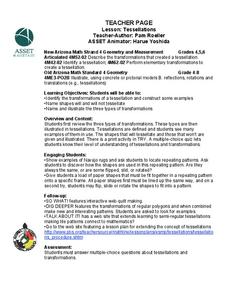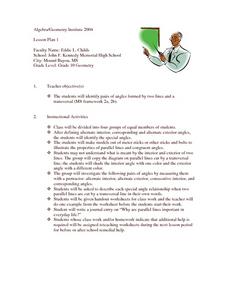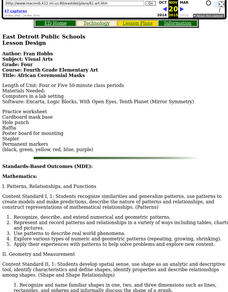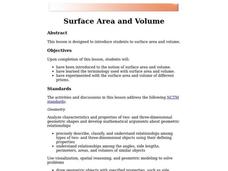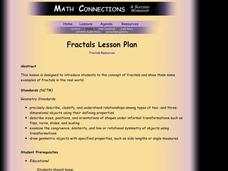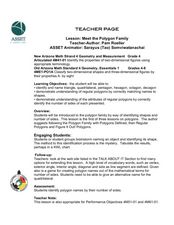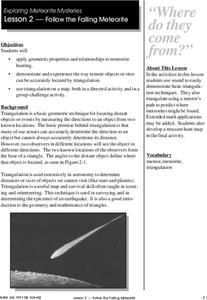Curated OER
Follow the Falling Meteorite
Students use triangulation method to locate meteorite landing site on the map. In this earth science lesson, students participate in a meteorite treasure hunt set up by the teacher. They explain how this method is used by scientists to...
Curated OER
How many isosceles triangles can you find?
Seventh graders recognize the characteristics of isosceles triangles. In this isosceles triangle lesson, 7th graders use geoboards to create isosceles triangles. Students record results and explain why they have an isosceles triangle.
Curated OER
Parallel and Perpendicular Lines
Learners study parallel and perpendicular lines. For this parallel and perpendicular lesson, pupils explore 2-D shapes and determine if the sides are parallel or perpendicular.
Curated OER
Segment and Distance
Learners explore the definitions of segment and distance. They perform hands-on activities to form a segment and examine distance. Following teacher guidance, they construct congruent line segments. Independently, they find the...
Curated OER
Equilateral Triangles
Students examine the attribute of equilateral triangles. In this equilateral triangle lesson, students examine a number of paper triangles to determine how they are classified. They determine how triangles are depicted in Navajo rugs.
Curated OER
Figure It Out - Polygons
Sixth graders explore different polygons. In this polygon lesson, 6th graders examine a rhombus, quadrilateral, parallelogram, and rectangles. Students compare and contrast polygons and research shapes on the Internet.
Curated OER
Pythagorean Theorem
Students explore how the Pythagorean Theorem works and how to apply it.
Curated OER
Pythagorean Theorem
Students are introduced to the Pythagorean theorem. They use three different activities that give students the opportuntiy to observe triangles, and use the Pythagorean theorem and practice different ways of determining areas of...
Curated OER
If you have to find the area of a region, how would you calculate it?
Fifth graders find the area of rice farms. In this area instructional activity, 5th graders draw shapes and grid them to find the area. They compare different rice fields to see which one takes up more space and has the larger area.
Curated OER
The Quadratic Formula
Students solve quadratic function by completing the square. In this algebra lesson plan, students use the quadratic formula to factor quadratics and find the roots. They graph the parabola and identify its properties.
Curated OER
From Where to Where?
Students find locations based upon their latitude and longitude coordinates. In this latitude and longitude instructional activity, students locate points on a grid and learn how to use an astrolabe.
Curated OER
Tessellations
Students form repeating patterns using tessellations. In this tessellations lesson plan, students identify shapes and illustrate three types of transformations. A website is included with the lesson plan which provides extension...
Curated OER
Transversal and Angles
Tenth graders identify angles formed by parallel lines and a transversal. Using meter sticks and bolts, they perform hands-on activities to demonstrate the properties of parallel lines and congruent angles. They color code diagrams to...
Curated OER
Sorting
Students sort a variety of manipulatives and use a software program that provides more sorting practice.
Curated OER
Finding The Circumference Given The Radius
Students develop an understanding of pi and the relationship between the diameter, radius and circumference. After a lecture/demo, students use construction paper and a compass to solve problems using diameter, radius and circumference.
Curated OER
African Ceremonial Masks
Fourth graders examine and discuss the purposes and traditions of African ceremonial masks. They design and create African ceremonial masks using various materials.
Curated OER
Surface Area and Volume
Students are introduced to the notion of surface area and volume. Students review surface area and volume by finding the area of a two-dimensional shape. They practice using the computer to create different surface area shapes.
Curated OER
Math: Gears and Wheels
Twelfth graders solve problems involving linear and angular speed. Using information about a compact disc, they solve the problem using multiple rates and conversion factors. Students also solve additional problems involving bicycle...
Curated OER
Ship Shape
Second graders explore shapes. After reading books about shapes, 2nd graders describe the properties of various shapes. They identify shapes if they have been rotated, flipped, or slid. Students create shapes using drawings and geoboards.
Curated OER
Fractals
Students explore the concept of fractals. In this fractal lesson, students use applets to explore Koch's Snowflake, Sierpinski's Triangle, and other fractals. Students develop these concepts through exploration and teacher guided...
Curated OER
Meet the Polygon Family
Fourth graders investigate regular polygons. In this regular polygon lesson, 4th graders explore the attributes of different polygons. Students work in groups to complete a KWL chart regarding polygons.
Pennsylvania Department of Education
Creating Polygons
Students describe, make and compare polygons. For this creating polygons lesson, students identify properties of quadrilaterals and describe common features of two dimensional shapes.
Curated OER
Follow The Falling Meteorite
Young scholars investigate the supposed traveling path of a meteorite. They use sound in order to triangulate the path. The results of the experiment are written on a map to display the path of the meteorite. The culminating activity is...
Curated OER
Justifying Mathematical Conjectures
Sixth graders, in groups, explain why they think something. This requires students to listen to and respond to each other. In this particular lesson, 6th graders explain to their classmates when one can or cannot construct a specific...











